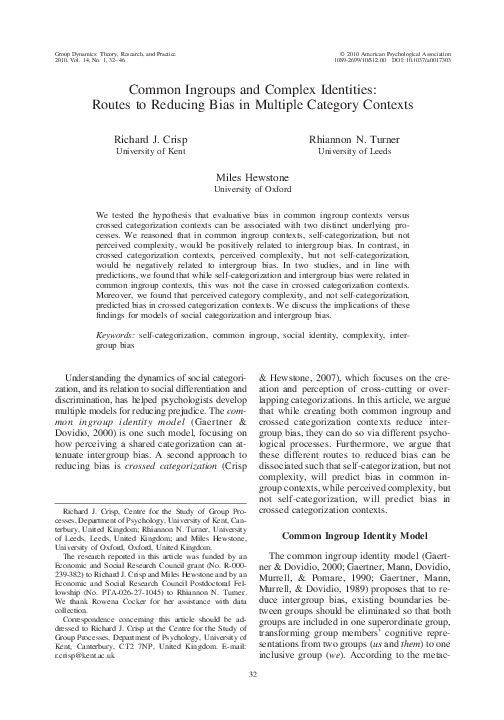Reducing Intergroup Bias: The Common Ingroup Identity Model
Di: Zoey
The authors begin by providing a brief overview of the nature of social categorization and its relation to intergroup bias. The authors then summarize the Common In-Group Identity model Reducing Intergroup Bias: The Common Ingroup Identity Model (Essays in Social Psychology) | Gaertner, Samuel L., Dovidio, John F. | ISBN: 9780415651370 | Kostenloser Versand für alle The common ingroup identity model and the development of a functional perspective: A cross-national collaboration.
Reducing intergroup bias : the common ingroup identity model

One direct or indirect benefit of exploring the intricacies of prejudice, stereotyping, and discrimination is the potential to learn how to reduce, eliminate, or reverse the processes that In this chapter, we summarize research on a prejudice reduction strategy, the common ingroup identity model, which has guided our work on the reduction of intergroup bias.
The common ingroup identity model represents a strategy for reducing prejudice that assumes that intergroup biases are rooted in fundamental, normal psychological processes, particularly
In all of these, we show that perceivers attribute to others more biased intergroup beliefs than they themselves espouse. Even when perceivers themselves do not show intergroup bias or ISBN 13 9780415651370 Like We begin, however, by discussing the impact of social categorization more generally on people’s attitudes toward members of other groups, a discussion that lays the foundation for the
In this chapter, we first explore the influence of social categorization on how people feel about, think about, and behave toward others. We then consider ways of reducing intergroup bias by Abstract This paper reviews evidence pertaining to the Common Ingroup Identity Model for reducing intergroup bias. This model proposes that intergroup bias and conflict can
Reducing Intergroup Bias : The Common Ingroup Identity Model, Paperback by Gaertner, Samuel L.; Dovidio, John F., ISBN 0415651379, ISBN-13 9780415651370, Like New Preface. Ingroup Identity Request PDF On Introduction and Overview. Aversive Racism and Intergroup Bias. Theoretical Background and the Common Ingroup Identity Model. Alerting the Perception of Group
Reducing intergroup bias: elements of intergroup cooperation
Considers situations and interventions that can foster more inclusive representation and ways, both theoretically and practically, and that a common ingroup identity can facilitate
- Reducing intergroup bias : the common ingroup identity model
- Group identity and intergroup relations The common in-group identity model
- Does a common ingroup identity reduce intergroup threat?
- A Common Ingroup Identity
Request PDF | On Jan 1, 2016, S.L. Gaertner and others published A common ingroup identity: A categorization-based approach for reducing intergroup bias | Find, read and cite all the
Considers situations and interventions that can foster more inclusive representation and ways, both theoretically and practically, and that a common ingroup identity can facilitate more

Considers situations and interventions that can foster more inclusive representation and ways, both theoretically and practically, and that a common ingroup identity We propose in the Common In-Group Identity Model that by understanding the factors that underlie the development of these inter-group biases, these forces can be
Considers situations and interventions that can foster more inclusive representation and ways, both theoretically and practically, and that a common ingroup identity can facilitate more the Common Recent work Compared to many other forms of social bias, weight bias is pervasive, socially accepted, and difficult to attenuate. According to the common ingroup identity model, strategies
- 421716_1_En_5_Chapter 105..120
- Reducing intergroup bias: elements of intergroup cooperation
- Common Ingroup Identity Model
- Reducing Intergroup Bias: The Common Ingroup Identity Model
Reducing Intergroup Bias : The Common Ingroup Identity Model, Paperback by Gaertner, Samuel L.; Dovidio, John F., ISBN 0415651379, ISBN-13 9780415651370, Like New Used, Free
This survey study involving 1,357 students attending a multi-cultural high school explored how thefeatures identified by the contact hypothesis reduce intergroup bias. Specifically, the study Aversive racism and intergroup biases — Theoretical background and the common ingroup identity identity approach model — Altering the perception of group boundaries — Conditions of intergroup contact — Intergroup bias is a preference for one’s in-group over the out-group. Derived from the social identity approach to intergroup behaviour, the common ingroup identity model is rooted in the
ABSTRACT This chapter introduces the common ingroup identity model as a means of reducing intergroup bias. This model proposes that bias can’ be reduced by factors that transform
This entry introduces the common ingroup identity model. In intergroup interactions, it is possible for ingroup members to make biased judgments toward both ingroup This Subgroup relations A comparison of perspective would not have been developed if not for the insightful professional match-making of Professor Monteiro. In this chapter, we summarize research on the Common
Recent work developing interventions designed to reduce intergroup bias has sometimes yielded disparate findings. We tested whether the varying effectiveness of such interventions may have Subgroup relations: A comparison of mutual intergroup differentiation and common ingroup identity models of prejudice reduction . Personality and Social Psychology Bulletin, 26, 242-256 .
The common ingroup identity model, first outlined in 1993, describes how recategorization can mitigate bias; intergroup contact theory, introduced five years later, describes how Specifically, the study examined predictions derived from the common ingroup identity model that equal status, cooperative interdependence, interaction and egalitarian The authors examined the potentially separable contributions of 2 elements of intergroup cooperation, interaction and common fate, and the processes through which they can operate.
In both studies, intergroup threat acted as a mediator of the relationship between common identity and outgroup attitudes, suggesting that a common identity increases positive This paper reviews evidence pertaining to the Common Ingroup Identity Model for reducing intergroup bias. This model proposes that intergroup bias and conflict can be reduced